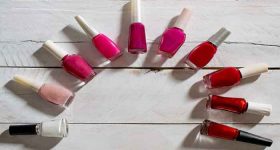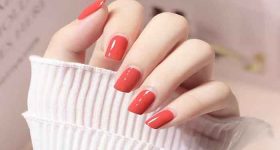Varnish: a delicate formulation

Touch of refinement, femininity and fantasy, nail polish is however a paradox in itself. Its consumption in the world continues to grow, while its controversial formulation is the subject of much ink.
Behind these pretty bottles of 5 or 10 ml with the most varied color palettes, hides a heavy chemistry that is not without consequences for our health and the environment.
Moreover, we often see a lack of transparency on the part of some industrialists; a height for a market that likes to display color!
The emergence of so-called “ecological” varnishes seems to provide a favorable response to an increasingly demanding clientele, eager to play with the codes of fashion without leaving their skin (or nails). But what is it really?
Zoom on the backstage of a market that sometimes cracks …
A BUOYANT MARKET
It is a very buoyant segment with 3.5 billion bottles sold per year (it has doubled since 2006) worldwide. In France, this represents a turnover of €7.4 million and growth of 7.8% in 2012. 20% of French women use nail polishes with a consumption of 2.4 units per buyer.
VARNISH CHEMISTRY
To satisfy the greatest number of consumers, nail polish must have multiple qualities such as the high adhesive power on which a durable resistance of the varnish depends, the shine, the ease of application, the high covering power, the hardness suitable to resist shocks, the fast drying time, the homogeneity of the formula, the flexibility and elasticity that make it possible to marry any changes in the surface of the nail without cracking.
To meet all these requirements, varnishes are generally composed of film-forming agents such as nitrocellulose, plasticizers such as camphor and DBP (dibutylphthalate), solvents such as ethyl acetate and butyl acetate, acetone and butanone, dyes such as azo derivatives, inorganic pigments or nacrant agents, rheological agents that provide viscosity and elasticity.
THE “BLACK TRIO” OF NAIL POLISHES
It is worth remembering that varnish appeared around 1920 following the manufacture of automotive paint and that, even if its composition has evolved, it remains a complex product that still resembles paint.
Among the most controversial substances, three substances called “The big 3” top the list. These are DBP or dibutylphthalate, toluene and formaldehyde.
Formaldehyde
The sworn enemy is formaldehyde, a volatile organic compound (called “VOCs”), which has the property of becoming gaseous at room temperature. Irritating to the eyes, nose and throat, it is easier to understand why the regulations impose maximum thresholds.
Indeed, according to the European Cosmetics Directive: “All finished products containing formaldehyde or formaldehyde-releasing substances must be included on the labelling the words ‘contains formaldehyde’ insofar as the concentration of formaldehyde in the finished product exceeds 0.05%”. According to INRS, “It has strong sensitizing and irritating properties and the available data indicate that the appearance of nasopharyngeal cancers is related to its irritating properties. The prevention of irritating effects therefore seems essential.”
IARC classified it in June 2004 in group 1 (human carcinogen) and in 2005, following an American study, the WHO classified it as a definite human carcinogen of the nasopharynx and nasal cavity. Formaldehyde is also reprotoxic, which can cause irritation, burning of the eyes and other allergies.
Phthalates
Phthalates (dibutylphthalate) are chemicals used in plastics. We are surrounded by them, both in plastic floors, in packaging, plastic toys or paints.
They are accused of being bad for the human reproductive system and of being involved in infertility.
Toluene
The last element of the trio, toluene is an aromatic solvent widely used in industry. It can irritate the nose, throat and skin that can absorb it, and also affect the nervous system.
It is also better to avoid:
- synthetic camphor, neurotoxic and dangerous for the central nervous system and for the peripheral nervous system,
- rosin, a resin that binds and sticks and is irritating and allergenic,
- as well as xylene, an element belonging to the family of organic compounds, very toxic, which can affect the nervous system (headaches, nausea …) and create skin irritations more or less severe.
The effects of VOCs are often difficult to demonstrate. They are highly variable and depend on individual sensitivity, their concentration in the air, exposure times or combinations between products.
However, it is confirmed that, depending on the concentration, regular exposure to VOCs can lead to different disorders: eye or throat irritation, allergies, headaches, asthma attacks, hives, nausea, fatigue.
A report by the Swiss television RTS dated 5 June 2012 also showed, during a study carried out by an independent laboratory in Lausanne, that of the 53 VOCs studied, some varnishes showed traces of 20 to 25 of these products. Then remains the eternal question of what is called the “cocktail effect”, whose consequences on our health are still unknown to this day.
AN ECOLOGICAL ALTERNATIVE: “ECO-FRIENDLY” VARNISHES
We hear a lot about organic varnish on the market. However, there is often a confusion between “organic varnish” and “ecological varnish”:
- ‘organic varnish’ means ‘certified organic varnish containing at least 95 % of natural ingredients or of natural origin, and at least 10 % of the total ingredients from organic farming’,
- by “ecological varnish” we mean a varnish that is more respectful of our skin and the environment than traditional varnishes.
At present, formulating a varnish that meets the criteria of organic certification is not easy. There was indeed a marketing of a certified organic varnish, but which has since been withdrawn.
The Léa Nature brand had indeed developed an ecological So’Bio nail polish that sought to do without nitrocellulose. This varnish was certified by Ecocert and bore the Cosmébio label: it used a resin from the secretion of caterpillars to give the varnish qualities of resistance. The brand, which has the great merit of having “wiped the plasters”, has not said its last word and is working on a new formulation.
The Kure Bazaar brand has achieved the feat of producing a formula of up to 85% natural origin based on wood pulp, cotton, corn, potato and wheat with great qualities of hold.
Ecological varnishes, mostly formulated on the policy of
“free”, are
a great success on the nail polish market. They are less irritating and
polluting and guarantee for some to meet the formulation requirements. Among
them are:
- “3 free” varnishes: they are formaldehyde-free, DBP (dibutylphthalate) and toluene-free.
- “4 free” varnishes: they are free of formaldehyde, DBP, toluene, formaldehyde resin or camphor.
- “5 free” varnishes: they are free of DBP (dibutylphthalate), toluene, formaldehyde, formaldehyde resin and synthetic camphor.
- The so-called “water” varnishes: they are 5 free and water.
WATER VARNISHES
Among the ecological varnishes, we find the so-called “water” varnishes. Devoid of nitrocellulose, formaldehyde, toluene, phthalates, xylene, petroleum dyes (FD&C and D&C, allergenic, irritants and carcinogens), these ecological varnishes are essentially composed of non-toxic natural pigments and acrylic polymers, i.e. non-aggressive resins.
Odorless and significantly less toxic than their conventional counterparts, these varnishes moisturize nails while significantly reducing the risk of allergy.
Still not widespread in France, some do not always have the expected outfit.
THE NEW GENERATION OF ECO-SOLVENTS
To remove nail polish, it is necessary to use ingredients with good solvent properties. The inexpensive and highly effective acetone is the most widely used, but its drying effects on the skin and nails, as well as its high volatility, which makes it irritating to the eyes and respiratory tract in addition to being highly flammable, are increasingly pushing manufacturers to offer “acetone-free” solvents. Most of the latter are based on ethyl acetate, a solvent that is also very volatile and therefore has similar disadvantages.
Some eco-solvents on the market consist of ethyl lactate, a solvent that is also flammable, but much less volatile than acetone and ethyl acetate, which minimizes the risk of inflammation and irritation by vapours for the eyes and respiratory tract. It is also much softer on the skin and nails. It can be 100% of vegetable origin, derived for example from the fermentation of sugar (from corn), easily biodegradable and produced by an ecological process.
CONCLUSION
Unconvincing until recently, many ecological varnishes now offer a very interesting alternative to traditional varnishes, offering convincing results that can meet the requirements of consumers, while taking care of their health.
Be aware that the undesirable effects of traditional varnishes, which, repeatedly, can cause this “famous cocktail”, which can induce chronic conditions, are in the line of sight of your customers. In conclusion, choose brands capable of making them see all the colors, without making you turn black!
We recommend that you use the adequate manicure and pedicure set to take care of your nails before applying any kind of decoration.
Read also: Castor oil for nails: benefits, application


